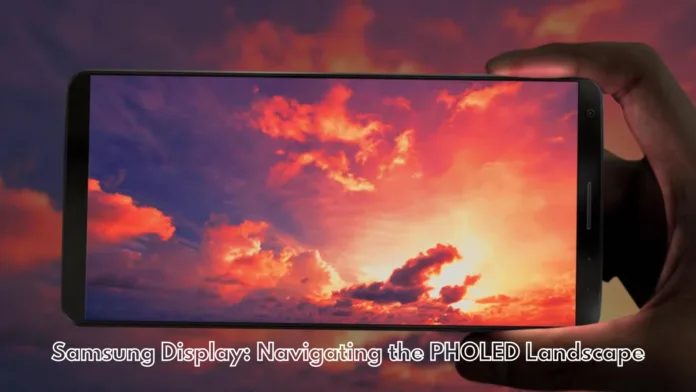Display technology is constantly evolving, with new breakthroughs paving the way for better visual experiences and device performance. Samsung Display, a display industry leader, has set a goal of incorporating PHOLED (Phosphorescent OLED) technology into its mobile OLED panels by the second half of 2025. This transition from current blue fluorescent OLED technology has enormous potential for improving energy efficiency and overall display quality. However, the advancement of this technology is fraught with difficulties, particularly in terms of material lifespan. This article delves into the complexities of PHOLED technology, examining Samsung Display’s goals and potential roadblocks.
Table of Contents
PHOLED: A Glimmer of Hope for Energy Efficiency
PHOLED technology emits light from phosphorescent materials, providing a significant advantage over the current blue fluorescent OLED approach. Phosphorescent materials have an internal luminous efficiency of 100%, whereas blue fluorescent OLEDs only have a 25% efficiency. This translates into significant energy savings, which could result in longer battery life for mobile devices and lower power consumption for larger displays.

The Blue Phosphorescent Challenge: Finding a Happy Medium Between Efficiency and Lifespan
While PHOLED promises impressive energy efficiency, the development of blue phosphorescent materials faces a significant challenge: lifespan. When compared to blue fluorescent OLEDs, current blue PHOLED materials are estimated to have a lifespan of only 55%. This shortened lifespan raises questions about the long-term durability of PHOLED displays, especially in high-usage devices like smartphones.
PHOLED Ambitions at Samsung Display: Ushering in a New Era
Despite the difficulties, Samsung Display remains committed to developing and incorporating PHOLED technology into its mobile OLED panels. PHOLED has the potential to revolutionize display performance and energy efficiency, according to the company. Samsung Display stands to gain a significant competitive advantage as the first manufacturer to mass-produce PHOLED panels.

Skepticism and Optimism in the Industry
The industry’s reaction to Samsung Display’s PHOLED ambitions has been mixed. Some experts are skeptical, citing durability concerns with blue phosphorescent materials. They believe that the lifespan issue will stymie PHOLED technology’s widespread adoption, particularly in mainstream consumer devices. Others, however, remain optimistic, citing Samsung Display’s extensive R&D capabilities and track record of innovation. They believe that Samsung Display will be able to overcome the longevity issue and usher in a new era of display technology.
Also Read: Samsung Galaxy Z FE: A Game-Changer in the Affordable Foldable Phone Market
The Road Ahead: Overcoming Obstacles and Capitalising on Opportunities
The path to PHOLED supremacy for Samsung Display is not without difficulties. The company must address the issue of blue phosphorescent material lifespan while also ensuring PHOLED panel performance and cost-effectiveness. If successful, Samsung Display has the potential to revolutionize the display industry by setting new standards for energy efficiency and visual quality.
Conclusion
The PHOLED ambitions of Samsung Display hold enormous promise for the future of display technology. PHOLED’s potential energy savings and performance enhancements could change the way we interact with our devices and consume digital content. While the road ahead will be difficult, Samsung Display’s commitment to innovation and track record of success suggests that the company is well-positioned to overcome these challenges and usher in a new era of display technology.
Disclaimer:
AI was used to conduct research and help write parts of the article. We primarily use the Gemini model developed by Google AI. While AI-assisted in creating this content, it was reviewed and edited by a human editor to ensure accuracy, clarity, and adherence to Google's webmaster guidelines.


